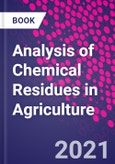Analysis of Chemical Residues in Agriculture presents a focused, yet comprehensive guide on how to identify, evaluate and analyze the wide range of chemicals that impact our food production system. The book presents a variety of analytical technologies and methods in order to help professionals, researchers, and graduate and undergraduate students understand chemical residues in agriculture and apply them to applications for the detection and quantification of chemical residues - both organic and inorganic - in several agricultural matrices, including crops, fruits, meat, food, feed, soil and water.
Agriculture remains one of the most strategic sectors for the global economy and well-being. However, it is seen as a source of environmental and health concerns mainly due to the high amount of pesticides and fertilizers used in production systems around the world; moreover, a thorough understanding of the topic is necessary when we consider livestock production systems also apply large amounts of veterinary drugs to treat illness and promote increases in productivity.
Please Note: This is an On Demand product, delivery may take up to 11 working days after payment has been received.
Table of Contents
1. Introduction to Organic and Inorganic Residues in Agriculture2. Agricultural Matrices3. Toxicology in Agriculture4. Main Analytical Techniques5. Fundamentals of Analytical Chemistry6. Analytical Methods to Selected Matrices








